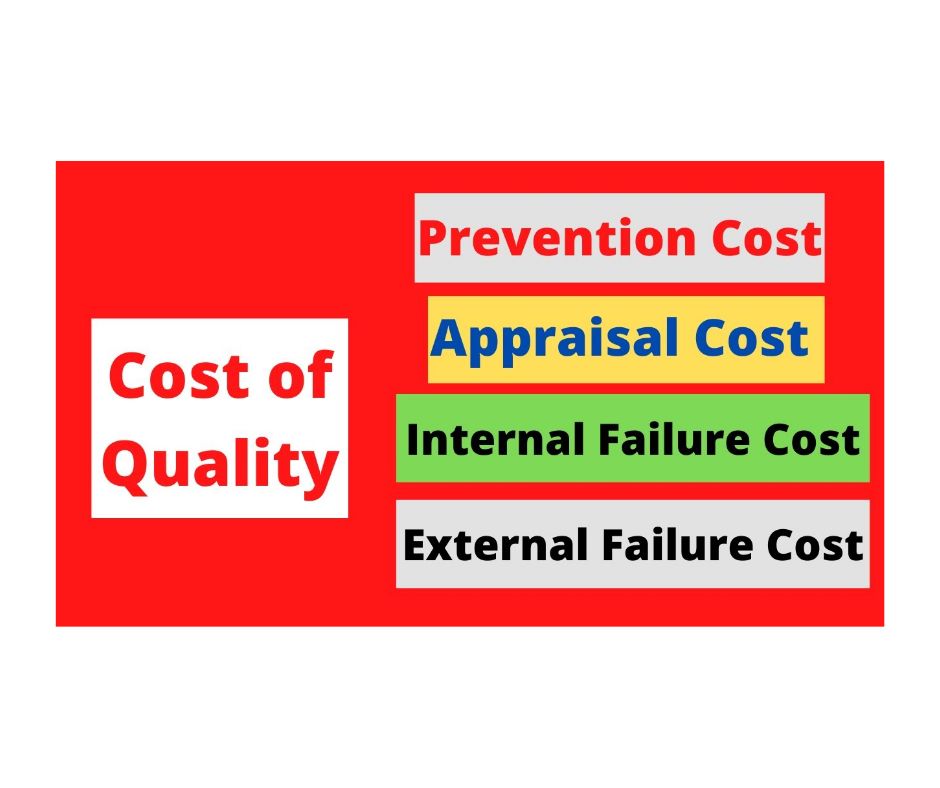Difference between prevention costs and appraisal cost
In the realm of quality management, businesses often deal with various costs related to maintaining and improving product or service quality. Two key categories of these costs are prevention costs and appraisal costs. Understanding the difference between these two types of costs is crucial for effective quality management and overall organizational efficiency.
Prevention Costs
The primary goal of these costs is to proactively address potential problems and improve processes to ensure high-quality outcomes. Prevention costs are often considered an investment in quality improvement, as they aim to reduce the likelihood of defects and failures.
Examples of prevention costs include:
- Training and Development: Investing in employee training programs to enhance skills and knowledge related to quality standards and best practices.
- Quality Planning: Developing and implementing quality management plans and strategies to ensure that processes meet established quality standards.
- Supplier Quality Management: Working with suppliers to ensure that materials and components meet quality requirements, including supplier audits and quality agreements.
- Process Improvement: Implementing continuous improvement initiatives, such as Six Sigma or Lean practices, to enhance operational processes and reduce variability.
By focusing on prevention, organizations aim to minimize the occurrence of defects and reduce the need for corrective actions, ultimately leading to higher customer satisfaction and lower long-term costs.
Appraisal Costs
Appraisal costs, on the other hand, are expenses related to evaluating and measuring the quality of products or services to ensure they meet established standards. These costs are incur after the production or service delivery process to detect and correct defects before they reach the customer. Appraisal costs are considered necessary to maintain quality control and verify that products or services meet required specifications.
Examples of appraisal costs include:
- Inspection and Testing: Conducting inspections and tests of products or services during and after production to identify any defects or deviations from quality standards.
- Quality Audits: Performing internal or external audits to assess compliance with quality management systems and standards.
- Quality Control Equipment: Purchasing and maintaining equipment used for measuring and testing product quality.
- Rework and Retesting: Costs associated with reworking or retesting products that fail initial inspections or tests.
Appraisal costs are essential for catching defects and ensuring that products or services meet quality expectations before they reach customers. However, these costs often reflect a reactive approach to quality management, addressing issues that could have been prevented through better processes.
Key Differences
The primary difference between prevention costs and appraisal costs lies in their timing and objectives:
- Timing: Prevention costs are incur before defects occur, focusing on improving processes to prevent issues. Appraisal costs are incur after the production or service delivery process, focusing on detecting and correcting defects.
- Objectives: Prevention costs aim to eliminate the root causes of defects and enhance overall quality, while appraisal costs aim to identify and correct defects to ensure that only quality products or services reach the customer.
In summary, both prevention and appraisal costs play important roles in quality management. By investing in prevention costs, organizations can reduce the need for appraisal costs and overall quality-related expenses. A balance approach that emphasizes prevention while maintaining effective appraisal practices can lead to improv quality, higher customer satisfaction, and greater long-term success.
FAQs:
What are prevention costs?
Prevention costs are expenses incur to prevent defects and ensure high-quality products or services before they occur, such as training and quality planning.
What are appraisal costs?
Appraisal costs are expenses relate to evaluating and measuring the quality of products or services to identify defects after production or service delivery.
Why are prevention costs important?
They help reduce the likelihood of defects, improve processes, and lower long-term quality-related costs by addressing potential issues before they arise.
Why are appraisal costs necessary?
They are necessary for detecting and correcting defects to ensure that products or services meet quality standards before reaching the customer.
Can prevention costs reduce appraisal costs?
Yes, investing in prevention can reduce appraisal costs by minimizing the number of defects that need to be detect and correct.
What are examples of prevention costs?
Examples include employee training, quality planning, supplier quality management, and process improvement initiatives.
What are examples of appraisal costs?
Examples include inspection and testing, quality audits, quality control equipment, and rework or retesting of defective products.
How do prevention and appraisal costs differ in terms of timing?
Prevention costs are incurred before defects occur, while appraisal costs are incur after the production or service delivery process.
Which is more cost-effective: prevention or appraisal?
Prevention is generally more cost-effective in the long run as it reduces the need for appraisal and corrective actions by addressing issues upfront.
Can an organization focus on both prevention and appraisal costs?
Yes, a balanced approach that emphasizes prevention while maintaining effective appraisal practices can lead to optimal quality management and customer satisfaction
For more information visit this site: https://www.mca.gov.in/
For further details access our website: https://vibrantfinserv.com

